|
Diving Thailand
Thailand has two good dive regions: one on the eastern side of the Thai Peninsula
in the Gulf of Thailand, best during the SW monsoon from May through November,
and the other on the Andaman Sea (western) side of Thailand, which has calmer
waters during the NE monsoon, December through April. Thai-based diving in the
Andaman Sea also includes the Andaman Islands, which are a part of India but two
times closer to Phuket than they are to mainland India, and the Mergui
Archipelago of Myanmar. Sadly, we got to neither of the latter places.
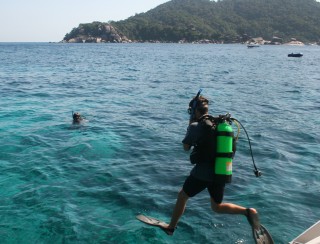
Chris entering the beautiful Similan Is. water |
We sailed the Andaman Sea islands and coast during January 2007. Dive centers are
located at all major tourist areas: Koh Phi Phi Don, several locations on
Phuket, and Krabi (on the mainland). It was a good place for dive
certification, with courses offered at competitive prices, and Amanda got her PADI Advanced card
while in Phuket. Diving options (if you don't have your own boat) include doing a live-aboard or being
shore-based and taking day trips. To dive the Similan Islands (guaranteed best clarity!) which are 60
miles to the NW of Phuket, it's easiest to live aboard, but day trips may be
offered from the west coast of Phuket; there is no accommodation on the islands. Living on Ocelot we had a
chance to dive both with shore-based companies in Phuket and to live aboard Ocelot while
in the Similans. High winds kept us from doing lots more diving in the Similans,
but we made do with snorkeling, which in itself was fantastic.
|
Click on a dive flag to go to our description of that dive
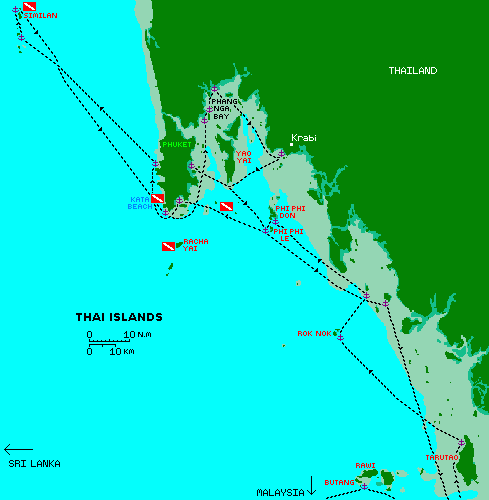 |
Medical care for divers and hyperbaric chambers are located on the island
of Phuket: in Patong at the Hyperbaric Service, at Vachira Phuket Hospital, and
at the Bangkok Phuket Hospital.
A good dive reference is Globetrotter's Dive Guide Thailand by Paul
Lees, which gives details on more than 140 dive sites in the country. All
underwater photos on this page, and their enlargements, are copyright Chris
Hacking 2007, except the lionfish by Amanda Hacking.
By the way: Phuket is pronounced "poo-ket" and may come from the Malay
"bukit" meaning hill. Koh, or Ko means island and may be spelled either way, and
is pronounced "kaw".
| Koh Racha Yai
-- Bungalow Bay |
| Type: |
Coastal dive |
| Access: |
Boat |
| Position: |
7° 36.7'N, 98° 21.9'E |
| Depths: |
10-100' (3-30m) |
| Date: |
12 January 2007 |
| Visibility: |
About 20' (6m) |
| Dive shop: |
13 miles north in Ao Chalong Bay, Phuket |
| Snorkeling: |
Yes, on the reef edges |
| Features: |
Small bommies and good fish life |
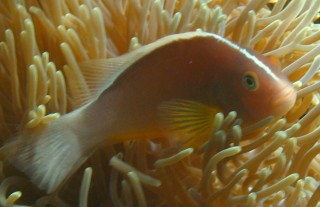
Pretty fish, yucky name. Skunk Anemonefish |
(Sue) None of the family dove this site, but our "adopted daughter"
Rachel did,
twice, while taking her PADI open water dive course. The poor visibility was especially
surprising, given that we were deep into the NE monsoon season and we figured
the seas had had plenty of time to let the sediment settle. (Now we hear it has
more to do with state of the tide than season, per se.) Rachel's group went
as deep as 16 meters, finding no current. This area to the south of Phuket
(about 2 hours by dive boat) is not some of Thailand's finest diving, but is
great for training courses. Rachel reported some lovely sting rays and a good variety of fish life around
the hard coral bommies which were interspersed with sand. Bungalow Bay is on the
western side of Koh Racha Yai.
The fun of diving in areas without lots and lots of coral is that you get to
spend more time with the small fish that inhabit the small bommies. It's great to slow
down and really get to watch some of them as they dart here and there amongst
the tentacles of their home anemone (as in the case of the anemonefish) or
around their own private playground in the enfolding arms of a finger coral.
| Koh Doc Mai |
| Type: |
Wall and Drift dive |
| Access: |
Boat |
| Position: |
8° 26.4'N, 119° 34.0'E - A small island. |
| Depths: |
40-60' (12-18m) - deeper if you want sea floor at 103ft (31m) |
| Date: |
24 January 2007 |
| Visibility: |
20' (6m) |
| Dive shop: |
11 miles west in Ao Chalong Bay, Phuket |
| Snorkeling: |
No |
| Features: |
Wall with good coral cover. Lots of fish. |
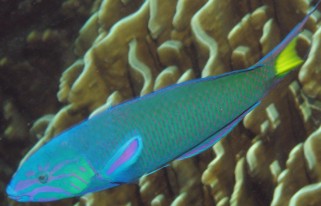
Lovely Crescent Wrasse on the reef |
(Amanda) We did this dive with Maria, the instructor from
Kon Tiki Dive in Phuket. This was part of the Advanced PADI course together with
Rachel from Australia and our friends Adam and Warren on Scud. We went by dive
boat with about 10 other divers, and somehow my internal compass got turned
around and I thought we were heading south - but Koh Doc Mai is basically due
east of Ao Chalong.
It was very rough on the surface by the island, a moderate-sized but
certainly not inhabitable rocky tree-covered mound. We descended
into nothingness and sediment before seeing a wall/bottom at about 60 ft (18m).
We swam north against the current, which was very strong. I nearly got pushed
into the wall several times, which wouldn't have been good for me or the coral.
The visibility was so bad sometimes Rachel and I (who were buddies) thought we'd
lost the group. We turned around at about 1/2 tank and drifted back at about 40
ft (12m) deep. When we had to turn the corner around the south end of the
island, the current nearly swept us away!
We saw many small chromis and damselfish and an eel near the beginning, plus
all the usual reef fish, like the wrasses and butterflyfish. On the wall were
lots of whip corals and colorful feathery crinoids. There are supposed to be
Leopard Sharks here often on the sand, but it was a good thing we didn't see one
- I'm fine with sharks, but ones I haven't seen before, coming out of the murky
depths only 20 ft away... that kind of puts me out of my comfort zone.
| King Cruiser Wreck |
| Type: |
Wreck dive. Deep dive. |
| Access: |
Boat, using mooring or live |
| Position: |
Approximately: 7° 48'N, 98° 38'E |
| Depths: |
45-106' (14-32m) |
| Date: |
24 January 2007 |
| Visibility: |
20' (6m) |
| Dive shop: |
16 miles west in Ao Chalong Bay, Phuket |
| Snorkeling: |
No |
| Features: |
Wreck of car ferry from 1997 |
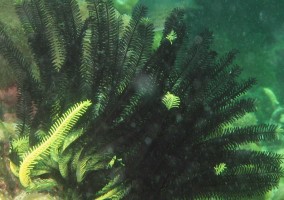
Beautiful crinoid, or feather star |
(Amanda) In 1997 an 80-foot car ferry traveling between Ko
Phi Phi Don and Phuket hit Anemone Reef (near Hin Mu Sang per nautical charts),
about 16 nm east of Phuket and sank. The reef itself had been declared a marine
sanctuary in 1992, and with the King Cruiser wreck splitting it in half, it made
sense to include the wreck as part of the sanctuary! Today the stern lies in 34
meters, the bow in 14 meters and is covered in marine life. Sorry, no photos of
the wreck itself.
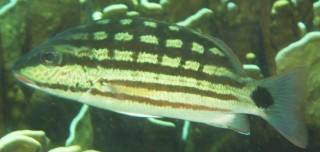
Checkered Snappers were common in Thailand |
Rachel and I did this as part of our Advanced Dive Course. We went with the
Kon Tiki Dive Center boat from Ao Chalong, Phuket to the mooring. Timing wasn't
good, as we were there with a swift current and subsequently poor visibility. We
splashed in 14 meters, following the bow line down, and I almost lost the group
when I had trouble equalizing pressure. We settled on the bottom in about 100'
(30m) where we did the usual "deep dive" questions: like writing our names
backwards, doing math, etc. then we swam back along the wreck. We saw some big
winch gear and toilets, plus lots of good fish, urchins, and coral. The wreck
was very rusty and covered in barnacles. Our dive book recommends not doing any
penetration as the decks are very unstable; best to "go" inside via dive light.
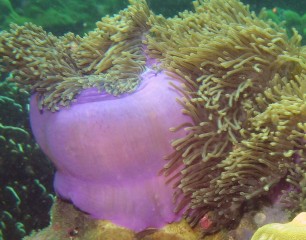
Bright underside of the Magnificent Anemone |
| Shark Point |
| Type: |
Rocky outcrop (Hin Mu Sang) on Anemone Reef |
| Access: |
Boat, using mooring or live |
| Position: |
Approx. 7° 47.9'N, 98° 37.6'E. Light on rock. |
| Depths: |
30-77' (9-23m) |
| Date: |
24 January 2007 |
| Visibility: |
20 - 30' (6-9m) |
| Dive shop: |
16 miles west in Ao Chalong Bay, Phuket |
| Snorkeling: |
No |
| Features: |
Coral bommies/pinnacles. Strong current is possible |

A Blue-Spotted Stingray with its black and white tail |
(Amanda) This site is north of King Cruiser Wreck, and
marked by a light on a single rocky outcropping, named Hin Mu Sang on nautical
charts. There was lots of sediment, as there was for the King Cruiser Wreck
dive, but viz was a little bit better. Maybe due to a different state of the
tide? This site has lots of coral bommies interspersed with sand. We saw rays
with black and white tails (couldn't see the blue spots through the murk),
several massive yellow sea fans, but no Leopard
sharks, despite the name of the site. Too bad our dive instructor got us lost -
we ended up doing most of the dive over a sandy bottom. Where did all the rocks
go? We surfaced pretty far from the dive boat, so had to inflate a sausage
to be picked up. It's probably
pretty cool with good viz (and a better oriented dive guide!) but that wasn't
our luck on January 24!
According to the Dive Thailand book, visibility here can vary from 13' (4m) to over
83' (25m). A line of pinnacles extends to the south of Hin Mu Sang, and just to
the west of this is a fabulous underwater arch covered in soft corals. This is
part of the Shark Point Marine Sanctuary, created in 1992. All flora and fauna
is protected, including corals and shells. One of those "Take only pictures,
leave only bubbles" places.
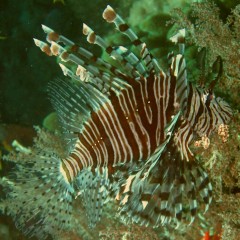
The beautiful Common Lionfish |
| Kata Beach |
| Type: |
Shore dive. Good night dive location |
| Access: |
Beach, or long-tail boat |
| Position: |
Approx. 7°49.5'N, 98° 17.3'E. |
| Depths: |
10-40' (3-12m) |
| Date: |
25 January 2007 |
| Visibility: |
15' (4.5m) |
| Dive shop: |
In Patong and Ao Chalong, Phuket |
| Snorkeling: |
Yes |
| Features: |
Coral bommies/sand patches. |
(Amanda) This was where we did both the Navigation dive
and the Night dive for our Advanced PADI cert. There wasn't much to recommend it
on the navigation (daylight) dive, but it was awesome at night! We entered
from the beach about an hour after sunset and spent most of the time around
15-26ft (4.5-8m) circling around bommies and over sand. There was one bommie
with (I counted) 10 lionfish, and we saw probably that many again during the
dive, including a cute little 2" (5cm) one!
There was a massive cuttlefish camouflaged against the sand and lots of
pufferfish sleeping in nooks on the rocks. And as my light hit the rocks, the
reflections of dozens of glowing red eyes came back to me -- shrimp, shrimp,
shrimp! On the way back Warren nearly swam into a jellyfish. The body wasn't
very big but the tentacles were wispy and very long. Very cool dive!
Similan Islands. These are a National Park about 60 nm northwest of
Phuket. We sailed from north western Phuket to the southern-most islands as a
day sail, staying a few days with cruising friends to snorkel and relax. Then
we sailed to the very north to join friends for some diving. The visibility out here is
fantastic -- the kind of thing we had hoped to find, but didn't, in the
islands south of Phuket. There are no shore facilities at all -- just cruising
boats, fishing boats (which are illegal, so hopefully just passing through), and live-aboard
dive boats.

A False Clown Anemonefish in its bulb anemone |
| Mooring Rocks, Koh Bangu |
| Type: |
Near-island, calm |
| Access: |
Boat only. There are several moorings available. |
| Position: |
8° 40.5'N, 97° 38.8'E |
| Depths: |
20-80' (6-24m) |
| Date: |
20 January 2007 |
| Visibility: |
60' (18m) |
| Dive shop: |
No, but live-aboard dive boats come most days |
| Snorkeling: |
Yes, along the shore of the islands and nearby bommies |
| Features: |
Nice fish, good corals, minimal current |
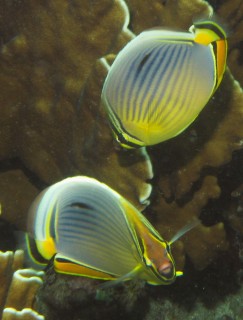
Hello, Indian Redfin Butterflyfish |
(Jon) This was a relaxing dive, right from the stern of
Ocelot. We were in the anchorage at the northern end of the Similan Islands which
are uninhabited and lie 60 nm NW of Phuket. It was our first Thailand dive, the
first with Chris on his 3-month visit with us, and the first dive with
Rachel
who was newly certified. Because of Rachel, we decided that an easy,
gentle dive would be best. Unfortunately we'd hit a time when the wind was howling
outside the island chain, making off-shore dives uncomfortable.
Chris, Rachel and I
splashed into about 20' (6m) of water and headed basically east around the
southern end of the island. This direction was more protected from the
prevailing winds and roiled seas. We descended down the slope to about 50'
(17m) and just followed the coral around. There were some lovely hard
corals but more surprising were all the tumbled rocks, which we'd never really
seen in previous dives. Coming up to about 35' (11m) on the way back the
corals got much more intense, with large formations and many different
varieties. We even saw some lobsters and lionfish. A fun dive!
(Sue) I didn't dive here (lack of tanks!) but I did lots of
snorkeling both here and at other islands in the Park. According to the Dive
Thailand book a cold current can pass between Ko Bangu and Koh Similan making it
a chilly dive at depth. It's recommended as a night dive when the current is
light, or at slack.
Our experience was that you can't really go wrong with visibility
and fish/coral life in the Similans! (But I don't know how it is during the SW
monsoon, June through November!) Our cruising friends sailed north to Koh
Bon in the Mu Koh Surin National Park and had some awesome dives with manta rays
and a whale shark. Missing the Similans and Mu Koh Surin would be to miss the
best of Thai diving.
Diving Pages:
Up | Diving Bonaire | Diving Tahanea | Diving Fakarava | Diving Toau | Diving Tahiti | Diving Moorea | Tonga (commercial) | Tonga (private) | Diving Fiji | Diving Indonesia | Diving Thailand | Diving Maldives
Related Pages:
Thailand Home | Thai Newsletters | Thai Diving | Thai Cruising Info | Thai Services | SE Asia Flora/Fauna
Underwater Pages:
Reef Animals | UW Photo How-to | Scuba Diving
Top Level:
Home |
Destinations |
Cruising Info |
Underwater |
Boat Guests |
Ocelot |
Sue |
Jon |
Amanda |
Chris |
Site Map |
Make a Comment
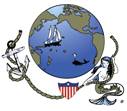 |
Lifetime
Commodores
of the
Seven Seas
Cruising
Association |
 |
|
If our information is useful,
you can help by making a donation
|
Copyright © 2000‑ Contact:
Jon and Sue Hacking -- HackingFamily.com, svOcelot.com.
All rights reserved.












